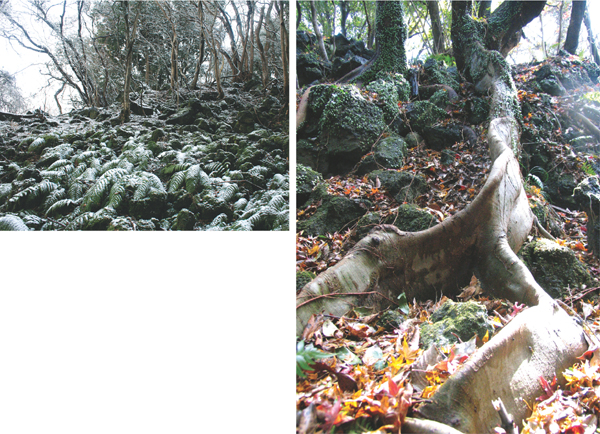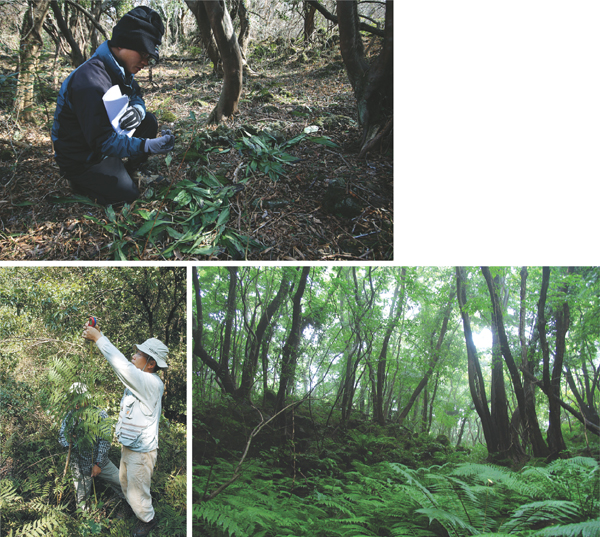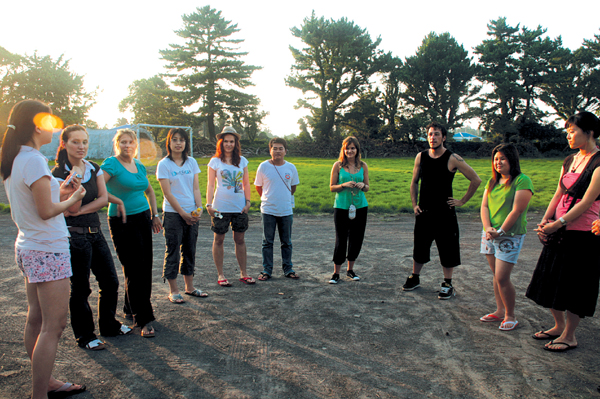
- Updated 2024.4.24 17:16
- All Articles
-
member
icon
-
facebook
cursor
-
twitter
cursor
|
NewsRenewable Energy |
No future without nature!Citizens’ movement fights to save Gotjawal regions from super-development |
|
| |
 |
|
| ▲ For most of the 20th century, the Gotjawal region was largely untouched by human hands, mainly due to its rocky ground being unsuitable for farming, which has allowed the forest’s ecosystem to flourish in a completely natural, utterly uncultivated way. Photos courtesy Gotjawal People |
In this global culture of progress and development there is always a balance to be found and often many sacrifices to be made. Whether it’s the destruction of the Amazon rainforest, known as the ‘Lung of the World’, or the Boreal forest, the world’s largest, covering parts of Alaska, Canada and Russia, there are always people who choose to fight the seemingly inevitable, who try to stand in the way of ‘progress’ in the name of defending nature.
Most people living on Jeju are unaware that this struggle of modern times- environment versus development, is also taking place here in earnest.
| |
 |
|
| ▲ The work of Jeju’s Gotjawal People is instrumental in the fight to save these valuable regions from development. By working tirelessly to research the impact of construction on this vital underground aquifer, they also raise awareness of the inevitable environmental consequences of losing Gotjawal. Photos courtesy Gotjawal People |
Gotjawal People
In 2005 a group of journalists working for the island newspaper Jeminilbo (Jeju People’s Daily Newspaper) compiled a report on the state of Jeju’s Gotjawal. This report brought to light for the first time, the impending threat of development for one of Jeju’s most important ecological attributes. After the report was published, journalist Kim Hyo-cheol helped to found the group Gotjawal People, a citizens’ movement whose sole aim is to make Jeju people realise why Gotjawal regions are so important and why they must be saved.
Jeju’s Gotjawal Forest spans four large regions across the island, Jocheon, Han-kyung, Aewol and Gujwa-Seongsan and encompasses 12% of Jeju’s land. Although Gotjawal is most commonly referred to as a forest, the word itself relates to the rocky, lava formations that lie beneath the moss of the forest floor. During the formation of Mt. Halla, around 1.2 million years ago, molten lava from the erupting volcano cooled and solidified in these areas, becoming a ten-metre thick layer of broken lava rocks, known as “Aa clinker”. These rocks form a natural, underground aquifer, into which 46% of Jeju’s rainfall permeates before pooling in naturally formed chambers. The captured rainwater then travels in rivulets down the mountain where it is siphoned for use; it is the main source of water for all of Jeju’s half a million inhabitants.
Kim quit his job as a journalist in 2006 and now works as a social worker and as manager of operations for Gotjawal People, a role he fulfils unpaid. In the group’s office, part of a former elementary school in Jocheon, he and the group’s only two fully paid members of staff work on their campaign daily. The group has 300 members in total and survives on their 10,000w a month donations; they are a non-governmental organisation, and although endorsed by the Jeju Provincial Government, receive no formal funding.
Consequences of development
In his office, surrounded by photographs, diagrams, and reports about Gotjawal, Kim explained just why it is necessary to save this region. The Gotjawal is the “Lung of Jeju”, he said, describing it’s “inhalation” as the permeation of rainwater down into the rocks, and its “exhalation” as the warming and evaporation of this water back up to the surface. This cycle of cooling and warming, means that in the winter the region is 10 degrees warmer than average temperature and vice versa in the summer. It maintains a mild, moist environment which allows many kinds of moss to grow, and sustains as many as 600 endangered species of plant, insect, and animals. “People think- no soil, no species, but it’s the opposite in Gotjawal areas,” he said, “it’s the perfect environment, and more and more previously unknown species are being discovered there.”
This is the main ecological reason to preserve Gotjawal, but there are others, which if ignored, may have more drastic consequences for Jeju’s human inhabitants. “We cannot see an immediate result, but long term it may contribute to rising sea levels,” Kim explained, as instead of water being absorbed into the aquifer it would flow straight down the mountainside and into the ocean. Jeju’s annual rainfall for the past 30 years averages at about 2,044 mm, which is high compared with other places at the same latitude. If Gotjawal was to be destroyed, an extra 46% of this water, which currently permeates into the aquifer, would remain on the surface of the island instead, and could cause severe flooding. “It would also contribute to climate change,” Kim said, and went on to explain that the forest itself also acts like a lung, in that it purifies the air through its consumption of carbon dioxide. The destruction of the forest itself would lead to an inevitable decrease in air quality.
| |
 |
|
| ▲ The 44th Youth in Community Action (YiCA) group, organised by UNESCO, traveled to Jeju in July this year, to learn about Gotjawal’s extraordinary ecosystem and ways in which they could get involved in its conservation. The group made an impassioned film about the region in response to their time on the island. Photo courtesy Gotjawal People |
Raising awareness
The efforts of Gotjawal People to draw attention to these issues have been far-reaching. In July this year the Korean National Commission for UNESCO (KNCU) held the 44th Youth in Community Action (YiCA). A group of 12 youths from 8 different countries visited Jeju’s Gotjawal as part of this tour, and spent 11 days exploring and learning about the region. In response to what they learned, they created a short film, with the slogan “No Future without Nature!” in English, which can be viewed on YouTube.
The group has also founded the Gotjawal Public Property Foundation, a joint effort between themselves and the Jeju Provincial Government. The aim is to buy up as much Gotjawal land as possible and place it under public ownership. The idea stems from the The National Trust in Britain which does something similar. 60% of Gotjawal land is owned by private individuals, the rest is owned by local government. By securing ownership they protect the land from private companies who would use it to develop on, and create a living inheritance for Jeju’s future generations. The group is in the process of completing the first step of this campaign, which is to identify key areas that they wish to purchase. The second step will be to raise funds to purchase the land and transfer ownership to the foundation.
Not everyone approves of their action, Kim commented, saying that some residents are pro-development of Gotjawal, often because they “want to sell their land” and selling to developers can be more financially rewarding. “We receive some angry letters”, he said, from residents who feel that Gotjawal People deepens conflict between regions, between those who are pro-development and those who are pro-conservation. The group receives much criticism for this, but also much support.
Gotjawal people also publish a regular newsletter, hold seminar days, and an ‘Eco Camp’ after school activity for local children. Children visit the Gotjawal forests to learn about them and take part in arts and crafts activities using natural materials from the forest. For adults, Gotjawal People hold scheduled seminars and workshop events where experts on the region provide information and give advice to individuals about how they can help. They also offer photography training and frequently host exhibitions of photographs taken by group members. All the while, Gotjawal People continue to spread awareness of this important issue and inform citizens about the possible consequences of Jeju’s continued development.
| |
 |
|
| ▲ As the temperature of the area remains mild and the air moist, at all times of year, thanks to the remarkable“ breathing”of the underground aquifer- many kinds of mosses, ferns and flowering plants are given the perfect environment in which to grow. Photos courtesy Gotjawal PeopleAs the temperature of the area remains mild and the air moist, at all times of year, thanks to the remarkable“ breathing”of the underground aquifer- many kinds of mosses, ferns and flowering plants are given the perfect environment in which to grow. Photos courtesy Gotjawal People |
Nature Vs Progress
Kim believes the construction of golf courses is a major threat, “it’s too saturated with golf courses so the government is trying to go for different things.” He said. He explained that the proposed Myth and History Theme Park and the Global Education City will be built on prime Gotjawal areas. Despite his and the group’s efforts, development increases. He feels the biggest limitation of his organisation is that most development plans are revealed to the public only after that have been put into motion by the Jeju Provincial Government. He went on to say that although the government conducts research and feasibility studies, they are rarely complete and are more often inadequate.
Gotjawal People conduct their own research studies into the impact of construction on the island, pointing out weaknesses in the government plans, and highlighting the environmental impact; yet their advice is rarely taken. He feels that often the government will class a site as not being part of Gotjawal, even though it is, to allow building on it. “The government shows support but actually it doesn’t bring any policy changes,” he said. Kim feels that they pretend to support to movement but implement no significant changes. He feels the concerns of Gotjawal People are being ignored.
“Over the last 100 years, the lives of Jeju people have drastically changed in the name of development.” Kim asserted. “It brings out a transformation of a way of life lived for many thousands of years.” He feels modern people need to change their new way of life to live in harmony with nature and that the government need to learn to maintain sustainable development and the important balance between progress and environment. It is a heart-felt concern that one can only hope the Jeju government will learn to listen to before it’s too late. “People living in Seoul can live without a forest but Jeju is very different; the criteria for happiness are different. It is a blessing to live with Gotjawal.” He said.
Kim and the other member of Gotjawal People do not speak English; however they would very much like foreigners to become involved in their work. If you are interested in conservation and have a Korean friend happy to join you, you are more than welcome to attend Gotjawal People’s next photography exhibition on the 20th Nov to learn more. Information in Korean can be found at www.gotjawal.com. The video made by the 44th YiCA can be found at http://www.youtube.com/watch?v=sHthzVJCL_c
|
|
|
|
|
|
|
|
ⓒ Jeju Weekly 2009 (http://www.jejuweekly.net)
All materials on this site are protected under the Korean Copyright Law and may not be reproduced, distributed, transmitted, displayed, published without the prior consent of Jeju Weekly. |
|
|
|
|
| Jeju-Asia's No.1 for Cruise |
|
|
|
Title:The jeju Weekly(제주위클리) | Mail to editor@jejuweekly.net | Phone: +82-64-724-7776 Fax: +82-64-724-7796
#503, 36-1, Seogwang-ro, Jeju-si, Jeju-do, Korea, 63148
Registration Number: Jeju, Ah01158(제주,아01158) | Date of Registration: November 10,2022 | Publisher&Editor : Hee Tak Ko | Youth policy: Hee Tak Ko
Copyright ⓒ 2009 All materials on this site are protected under the Korean Copyright Law and may not be reproduced, distributed, transmitted, displayed, published
without the prior consent of jeju weekly.com.

|























